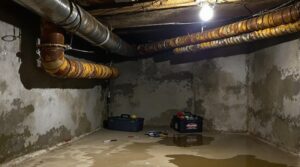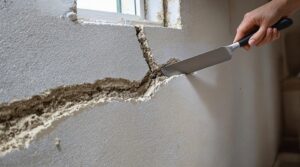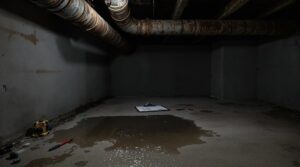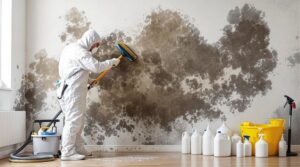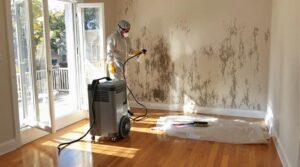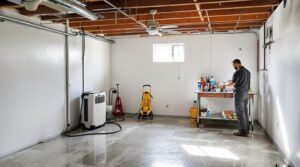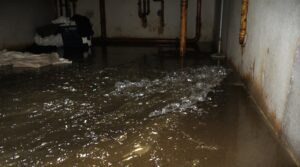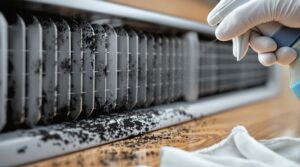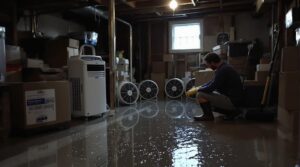Removing basement mold requires proper safety equipment including P100 respirators, goggles, and protective suits. Initial steps involve identifying and fixing moisture sources through foundation inspection and humidity control. Cleaning methods range from natural solutions like vinegar mixtures to EPA-registered products for severe cases. Professional assessment may be necessary for extensive contamination. A systematic approach combining protective measures, effective cleaning, and long-term moisture prevention guarantees successful mold remediation and future protection.
Key Takeaways
- Use proper safety equipment including P100 respirator, gloves, and Tyvek suit before attempting any mold removal.
- Control basement humidity levels below 60% using dehumidifiers and regularly monitor with hygrometers.
- Clean affected areas with EPA-registered products or natural solutions like vinegar and water mixture.
- Fix all water leaks, repair foundation cracks, and ensure proper drainage to prevent future mold growth.
- Consider professional remediation services for severe cases, especially with black mold covering large areas.
Understanding Basement Mold Types and Their Risks
Living in damp and dark conditions, basement mold presents significant health and structural risks that require immediate attention and proper identification.
Among the common mold variations, Stachybotrys, known as black mold, poses the most severe health threats through its toxic properties and association with respiratory complications.
Other prevalent types include Trichoderma, displaying greenish-yellow growth patterns, and Aureobasidium, which spreads rapidly in moisture-rich environments.
Understanding these variants is essential as each type presents distinct risks. While Ulocladium resembles black mold visually, it carries fewer health risks.
However, Aspergillus combines both allergenic and toxigenic properties, potentially causing serious pulmonary infections. The fungus creates harmful aflatoxin compounds that have been linked to cancer development.
The presence of any of these mold species can compromise indoor air quality, as spores travel through ventilation systems and affect the entire household.
Exposure to these molds often triggers postnasal drip and persistent coughing in susceptible individuals.
Additionally, certain mold types can deteriorate wooden structures, leading to long-term structural damage if left untreated.
Essential Safety Gear and Preparation Steps
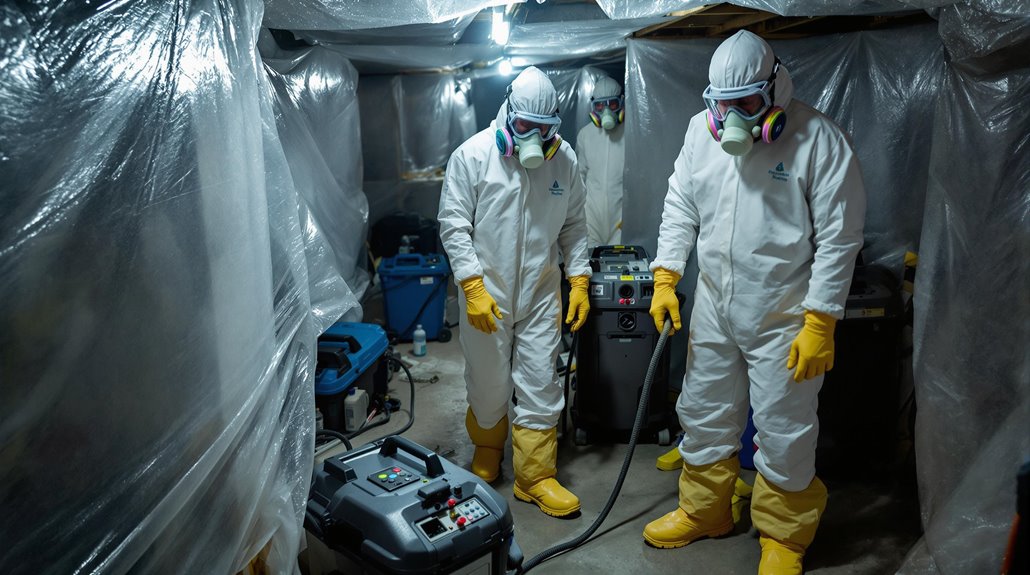
Before undertaking basement mold removal, workers must equip themselves with essential protective gear including P100 respirators, nitrile gloves, goggles, and full-body Tyvek suits to prevent exposure to harmful spores.
The establishment of containment areas using plastic sheeting and tape prevents cross-contamination between affected and clean spaces during remediation. Proper use of waterproof boots helps prevent moisture penetration and reduces the spread of mold spores across different areas.
Strategic placement of ventilation systems, including negative air machines and HEPA filtration units, guarantees proper airflow control and helps maintain a safe working environment. Areas larger than 10 square feet require professional containment protocols to ensure safe and effective remediation.
Required Personal Protection Equipment
Safety equipment stands as the first line of defense when tackling basement mold removal. Proper respiratory protection, combined with thorough body coverage, guarantees safe remediation procedures. Essential equipment must be maintained and inspected before each use to guarantee effectiveness. Incorrect handling of contaminated areas can lead to respiratory disorders among workers. Quaternary ammonium compounds require extra ventilation during application.
| Protection Type | Required Equipment | Purpose |
|---|---|---|
| Head/Face | N95 Respirator, Goggles | Prevents spore inhalation |
| Body | Disposable Coveralls | Full-body contamination barrier |
| Hands/Feet | Rubber Gloves, Shoe Covers | Protection from direct contact |
| Additional | Hair Cover, Face Shield | Enhanced safety measures |
For large-scale infestations exceeding 10 square feet, professionals recommend full-face respirators with P-100 filters. Equipment maintenance includes regular cleaning of reusable components and proper disposal of single-use items. All protective gear should create a complete seal, preventing exposure to harmful mold spores during the remediation process.
Setup Safety Containment Areas
Proper containment setup forms the foundation of successful mold remediation projects. The process requires careful assessment of the affected area to determine whether limited containment (10-100 square feet) or full containment (over 100 square feet) is needed.
Safety barriers must include double layers of polyethylene sheeting secured with sealing tape to isolate contaminated areas from unaffected spaces. A decontamination chamber with slit entries and covering flaps is essential for safe entry and exit.
The containment area requires HEPA air filtration and dehumidification equipment to control moisture levels and prevent spore dispersal.
Professional standards mandate regular monitoring of containment integrity and proper decontamination procedures for all equipment before removal. This systematic approach guarantees both effective remediation and the protection of occupants throughout the process.
Workers must maintain negative air pressure of at least -5 Pascals within the containment zone to prevent mold spores from escaping.
Proper Ventilation Systems Placement
Establishing effective ventilation systems requires thorough safety preparation and specialized equipment deployment. The E-Z Breathe Ventilation System optimizes airflow through strategic ventilation placement, creating static pressure that exchanges stale basement air with fresh air from upper levels. Professional installation guarantees proper system integration with existing HVAC components while maintaining energy efficiency.
| Safety Equipment | Installation Requirements |
|---|---|
| P100 Respirator | Sealed Foundation Cracks |
| Full Tyvek Suit | Clean Window Wells |
| Nitrile Gloves | Maintained Gutters |
Before system installation, technicians must conduct thorough pre-installation checks, including foundation inspection and moisture barrier verification. The ventilation placement considers peak airflow patterns to maximize system effectiveness while maintaining proper humidity control. This systematic approach guarantees the basement environment remains protected from mold growth while providing clean, circulated air throughout the space. Maintaining indoor humidity below 65% is crucial for preventing mold development in basement environments.
Identifying and Fixing Moisture Sources
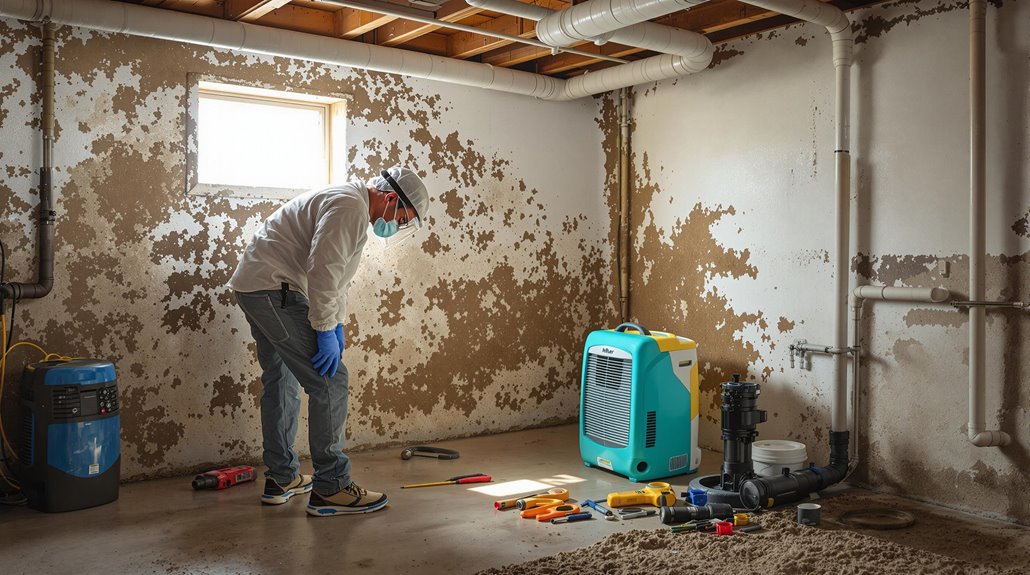
Before tackling basement mold remediation, homeowners must first identify and address the underlying moisture sources that create favorable conditions for mold growth. This process requires systematic moisture detection and water mapping to pinpoint specific problem areas throughout the basement space.
Common moisture sources include liquid water infiltration through foundation cracks, inadequate drainage systems, and plumbing leaks.
Interior moisture can accumulate from poor ventilation, unvented appliances, and high indoor humidity levels. Structural issues, such as compromised floor joist connections and insufficient window well drainage, can also contribute to moisture problems.
To address these issues effectively, implement a complete moisture control strategy. This includes maintaining proper drainage through regular gutter cleaning, ensuring correct ground grading, installing effective sump pump systems, and sealing structural gaps.
Additionally, controlling indoor humidity through dehumidification and proper air circulation helps prevent conditions conducive to mold growth.
Without proper moisture control, black mold growth can begin within 24-48 hours of water exposure, leading to serious health risks including respiratory damage and memory loss.
Best Cleaning Solutions for Mold Removal
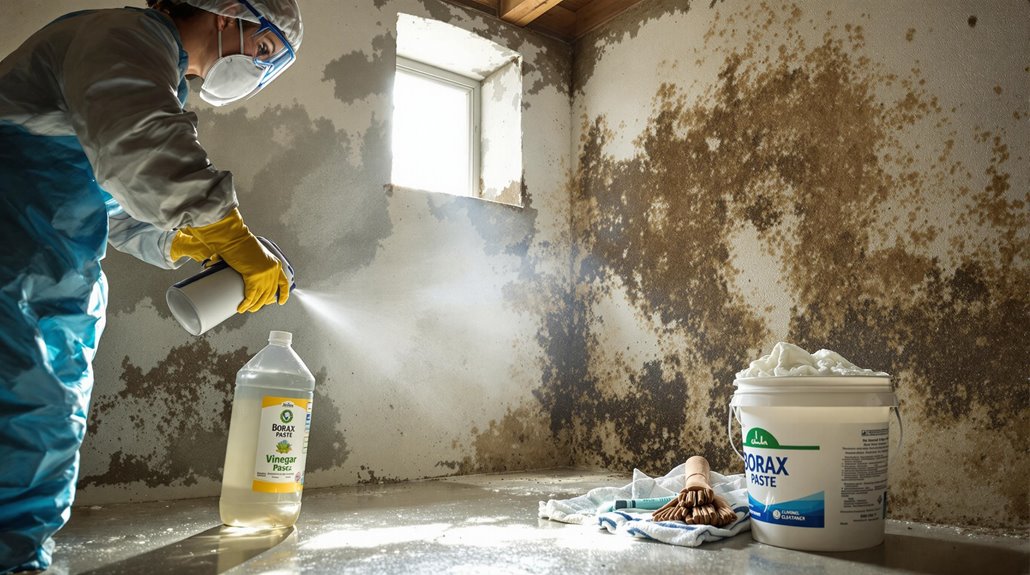
When selecting cleaning solutions for basement mold removal, homeowners must consider both the type of surface affected and the extent of mold growth to determine the most effective treatment approach.
Natural cleaning mixtures like vinegar and baking soda offer safe, non-toxic options for treating most household mold, while chemical solutions may be necessary for severe infestations.
For best results, follow these proven solution ratios:
- Mix one cup of borax with one gallon of water for a powerful natural paste
- Combine equal parts water and white vinegar in a spray bottle for direct application
- Dilute bleach with water in a 1:10 ratio for non-porous surface treatment
Professional remediation services typically charge $500 to $3,000 for comprehensive basement mold treatment depending on contamination severity.
When dealing with extensive mold growth, EPA-registered products like Concrobium provide professional-grade effectiveness.
Regardless of the chosen cleaning solution, proper safety equipment, including gloves, masks, and eye protection, must be used during application, and adequate ventilation should be maintained throughout the cleaning process.
Step-by-Step DIY Mold Removal Process
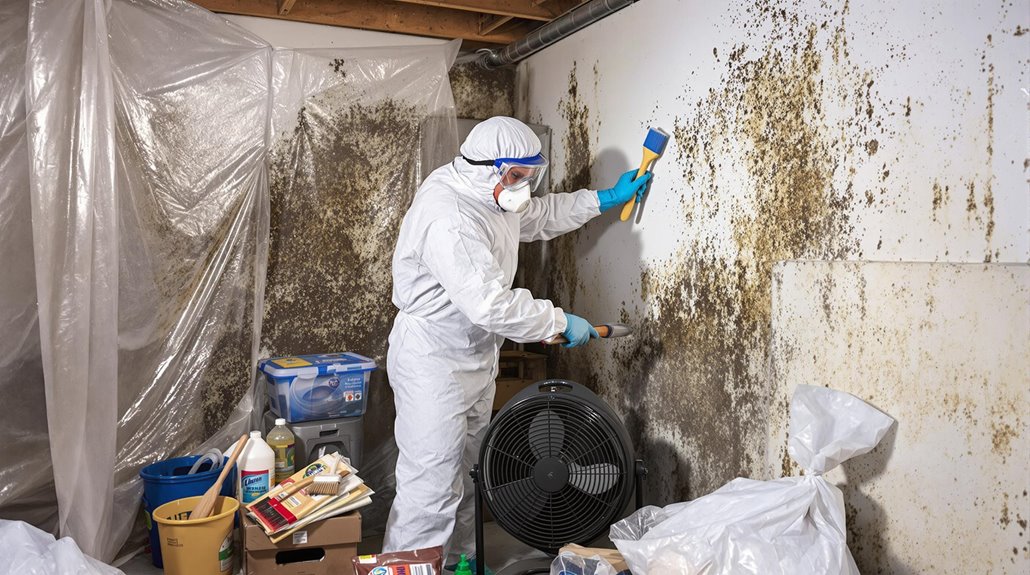
Removing basement mold requires a systematic approach that combines proper safety measures, effective cleaning solutions, and thorough sanitization techniques. The process begins with sealing off the affected area and donning appropriate protective gear, including an N95 mask and goggles. Proper HEPA vacuuming techniques are essential since mold counts can increase up to 1,000 times during the removal process.
| Step | Action |
|---|---|
| 1 | Seal affected area with plastic sheets |
| 2 | Remove contaminated items and furniture |
| 3 | Apply chosen cleaning solution in circular patterns |
| 4 | Implement proper scrubbing techniques |
| 5 | Dry area thoroughly with fans |
Once the area is prepared, cleaning solutions such as white vinegar or hydrogen peroxide are applied using consistent cleaning patterns. Scrubbing techniques should follow a methodical approach, working from top to bottom and using stiff-bristled brushes to remove visible mold. After thorough scrubbing, the area must be rinsed with clean water and dried completely using fans or dehumidifiers. Proper disposal of contaminated materials in sealed plastic bags completes the removal process.
Professional Remediation: When to Call Experts
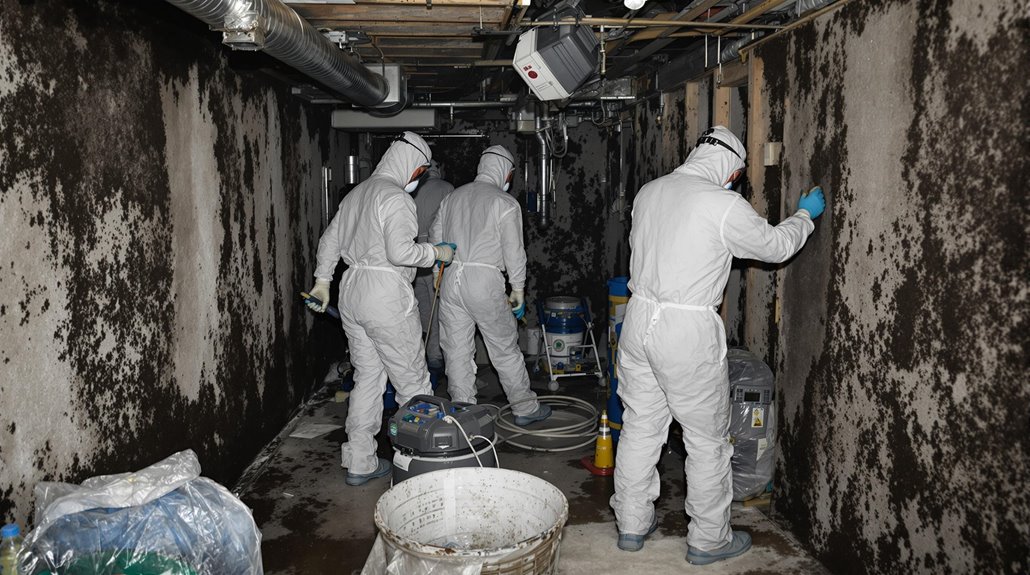
While small mold problems can be addressed through DIY methods, extensive contamination covering over 10 square feet requires professional remediation services that typically cost between $500-$6,000 depending on severity.
Key indicators that professional help is needed include widespread growth, toxic black mold, post-flood contamination, and compromised structural materials.
When selecting a mold remediation contractor, property owners should verify proper licensing, insurance, and industry certifications like IICRC's Mold Remediation Specialist credential.
Professional remediation experts utilize specialized HEPA filtration systems and containment equipment to safely remove hazardous mold growth.
Cost vs. DIY Analysis
The decision between DIY mold removal and professional remediation requires careful cost-benefit analysis.
While DIY approaches may seem cost-effective initially, a thorough value assessment must examine long-term implications. Professional remediation, averaging $2,366, provides expertise, specialized equipment, and thorough remediation that can prevent future expenses.
Key factors to evaluate in the cost analysis include:
- Size of infestation: Areas larger than 10 square feet typically require professional intervention
- Location accessibility: Hidden mold behind walls or in HVAC systems demands expert handling
- Health considerations: Respiratory conditions warrant professional treatment to guarantee safety
Professional remediation offers efficiency and effectiveness that often justify the initial investment, particularly when evaluating potential property value impacts and the risk of recurring mold issues from incomplete DIY treatment.
Public adjusters can help maximize insurance compensation for professional mold remediation through detailed documentation and expert valuation methods.
Signs Professional Help Needed
Professional mold remediation becomes necessary when specific warning signs emerge in a basement environment. Key indicators include mold visibility exceeding 10 square feet, persistent musty odors, and health symptoms affecting occupants. A thorough moisture assessment often reveals hidden growth behind walls or under flooring, particularly in areas with water damage or high humidity.
| Warning Sign | Impact | Action Required |
|---|---|---|
| Large Coverage | >10 sq ft affected | Immediate professional intervention |
| Health Issues | Respiratory problems | Medical consultation and remediation |
| Hidden Growth | Structural damage | Professional inspection and testing |
When mold results from contaminated water, flooding, or sewage backup, professional expertise becomes essential. Additionally, if previous DIY removal attempts proved ineffective or the mold source remains unidentifiable, certified remediation specialists should be contacted to guarantee proper containment and elimination.
Choosing Qualified Contractors
Selecting qualified mold remediation contractors requires careful evaluation of their credentials, experience, and professional standards.
The contractor verification process must include license validation, insurance coverage confirmation, and thorough background checks through state regulatory bodies and consumer protection agencies.
Essential factors to evaluate when choosing a remediation professional include:
- Valid state-specific licensing and IICRC certification, particularly in states requiring specialized mold remediation credentials
- Complete liability insurance and workers' compensation coverage with adequate limits for project scope
- Documented experience with similar projects, supported by detailed written estimates, containment protocols, and verifiable local references
A qualified contractor should provide detailed documentation of their testing methodology, remediation approach, and use of industry-standard equipment like HEPA filtration systems.
They should also offer clear warranties and maintain transparent communication throughout the project.
Long-Term Prevention Strategies

Maintaining a mold-free basement requires implementing thorough prevention strategies that address moisture, waterproofing, and environmental conditions. Effective moisture management begins with proper drainage systems, including well-maintained gutters, downspouts, and grading that directs water away from the foundation. Installing and regularly servicing dehumidifiers and sump pumps helps maintain ideal humidity levels below 60%.
Comprehensive seasonal maintenance involves inspecting and repairing any foundation cracks, leaks, or water damage promptly. Interior and exterior waterproofing measures, such as applying waterproof sealants and maintaining French drains, provide essential protection against water infiltration.
Reducing organic material storage and implementing mold-resistant building materials further minimize potential growth conditions. Regular monitoring using hygrometers guarantees humidity remains controlled, while frequent cleaning and inspection of basement surfaces help identify and address issues before they escalate. These preventive measures, when consistently applied, create an environment inhospitable to mold growth and protect the basement's structural integrity.
Maintaining a Mold-Free Basement Environment
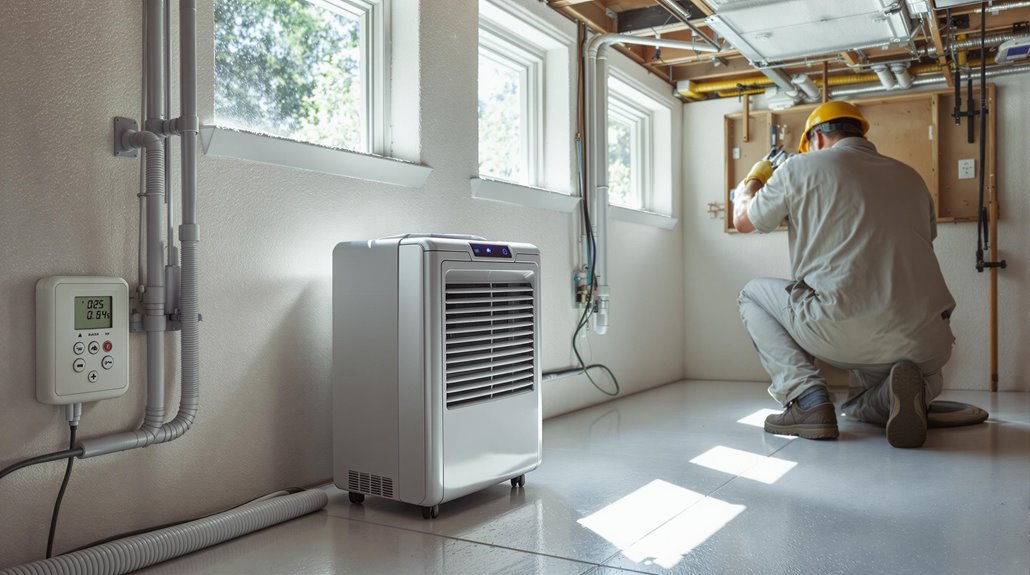
A thorough approach to preserving a mold-free basement environment requires consistent monitoring and maintenance of key environmental factors.
Regular humidity monitoring and ventilation maintenance serve as fundamental components in preventing mold recurrence.
Implementing a complete maintenance schedule guarantees early detection of potential issues before they escalate into significant problems.
Essential maintenance practices include:
- Daily monitoring of humidity levels using calibrated meters, maintaining levels below 60% through dehumidifier operation
- Weekly inspection of ventilation systems, including cleaning vents and ensuring proper air circulation throughout the basement
- Monthly examination of potential water entry points, such as window wells, foundation walls, and pipe penetrations
The integration of mold-resistant materials, coupled with proper insulation and waterproofing measures, strengthens long-term prevention efforts.
Regular cleaning and organization of basement spaces further support these maintenance protocols by eliminating conditions that could harbor moisture and promote mold growth.
The Benefits Of Consulting A Public Adjuster
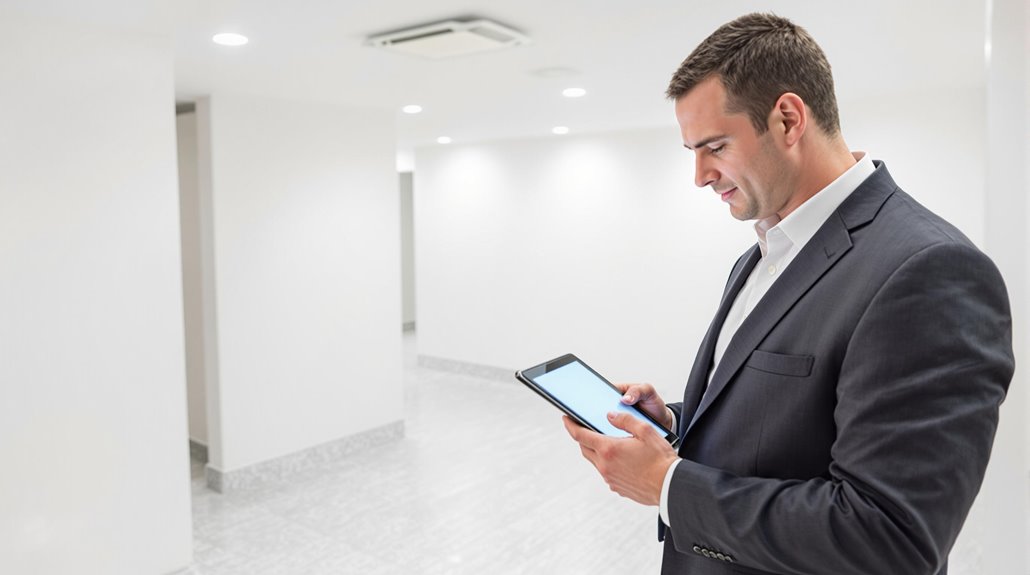
When dealing with basement mold insurance claims, a public adjuster provides expert guidance through complex policy requirements and documentation processes.
Their objective assessment methods and professional documentation of mold damage often result in higher claim settlements compared to self-filed claims.
Public adjusters streamline the entire claims process by managing all communication with insurance companies, conducting thorough damage evaluations, and ensuring complete coverage for necessary repairs and remediation.
Expertise In Insurance Claims
Dealing with basement mold issues through insurance claims requires specialized knowledge and expertise that public adjusters can provide.
Their thorough understanding of policy interpretation and ability to resolve coverage disputes guarantees maximum claim settlements for property owners affected by mold damage.
Public adjusters excel in three critical areas:
- Technical policy analysis to identify all available coverage and benefits related to mold remediation
- Documentation management, including detailed damage assessments and evidence collection
- Strategic negotiation with insurance carriers to secure fair compensation
Their expertise streamlines the entire claims process, from initial documentation to final settlement.
Public adjusters handle complex paperwork requirements while advocating for the policyholder's interests, enabling property owners to focus on mold remediation and restoration efforts rather than managing insurance complexities.
Objective Damage Assessment
Public adjusters provide essential expertise in conducting objective damage assessments for basement mold claims. Through exhaustive damage verification processes, they guarantee that all affected areas are thoroughly documented and evaluated. Their specialized equipment enables accurate moisture mapping and detection of hidden mold growth that may not be visible during initial inspections.
These professionals utilize advanced techniques to measure mold levels and assess the full extent of contamination throughout the basement space. Their detailed documentation includes photographic evidence, professional estimates, and thorough reports that support insurance claims.
This systematic approach helps identify the source of mold problems while ensuring that no damaged areas are overlooked. The resulting assessment provides vital evidence for negotiating with insurance companies and securing appropriate coverage for necessary remediation work and repairs.
Streamlined Claim Process
Streamlining the basement mold claims process requires strategic collaboration with public adjusters who possess specialized expertise in documentation and negotiation.
These professionals implement advanced claim optimization techniques while ensuring exhaustive documentation strategies that maximize settlement outcomes.
Their systematic approach encompasses digital claims submission, automated workflows, and real-time status updates.
Key benefits of professional representation include:
- Thorough validation of all damage through detailed inspection reports, photographic evidence, and professional assessments
- Expert interpretation of policy coverage and identification of hidden mold damage that might otherwise go unnoticed
- Strategic negotiation with insurance carriers, leveraging certification compliance and remediation plans to support higher settlement values
This structured approach to claims management substantially reduces administrative burden while ensuring accurate damage assessment and fair compensation for basement mold remediation.
Higher Claim Payouts & Settlements
Homeowners seeking maximum compensation for basement mold damage substantially benefit from partnering with public adjusters, who consistently secure higher claim settlements through their specialized expertise. Through detailed documentation and thorough damage assessments, public adjusters identify often-overlooked issues that profoundly impact settlement maximization.
Adjuster expertise in policy interpretation and negotiation tactics proves invaluable during the claims process. Working solely on behalf of policyholders, these professionals leverage their extensive understanding of insurance procedures to prevent underpayment and guarantee full compensation.
Their contingency-based fee structure aligns with the policyholder's interests, typically resulting in settlements that exceed what homeowners might achieve independently, even after accounting for the adjuster's percentage. This professional advocacy eliminates potential conflicts of interest and provides homeowners with dedicated representation throughout the claims process.
About The Public Claims Adjusters Network (PCAN)

Based on the provided facts, it is not possible to write a paragraph about "The Public Claims Adjusters Network (PCAN)" as there is no factual information available about this organization in the source material.
Instead, the available information focuses on effective mold removal methods and prevention in basements. While Network Expansion and Adjuster Certification are relevant topics in the insurance industry, the source material specifically addresses mold remediation techniques and safety protocols.
The key aspects of basement mold removal include:
- Application of appropriate cleaning solutions, such as bleach mixtures, vinegar solutions, or EPA-approved products like Concrobium
- Implementation of essential safety measures, including proper protective equipment and ventilation procedures
- Prevention strategies through moisture control, including dehumidification and structural improvements
Understanding these mold remediation processes helps property owners address basement mold issues effectively while maintaining safety standards and preventing future occurrences.
Frequently Asked Questions
Can Basement Mold Affect the Resale Value of My Home?
Basement mold drastically impacts property depreciation through reduced appraisal values and buyer hesitation. Potential buyers often demand remediation or offer lower prices, reflecting the perceived health risks and repair costs.
How Long After Water Damage Does Mold Typically Begin Growing?
While moisture timeline varies, mold can initiate growth within 24-48 hours of water exposure. Following established growth patterns, visible colonies typically develop and spread across surfaces within 1-2 weeks.
Will Homeowner's Insurance Cover Basement Mold Removal?
Homeowner's insurance covers basement mold removal only if caused by sudden, covered perils. Standard policies include insurance exclusions for gradual damage and maintenance issues, with specific coverage limits typically around $10,000.
Can Basement Mold Spread to Other Floors Through HVAC Systems?
Like an invisible invader, basement mold readily spreads through HVAC systems via airborne transmission. Duct contamination allows spores to circulate throughout the building, affecting all connected floors and living spaces.
Should I Test for Mold Before or After Attempting DIY Removal?
Testing should occur before attempting removal to identify mold types and assess health implications. Professional testing methods provide accurate analysis, ensuring appropriate safety measures and removal strategies are implemented.
References
- https://www.angi.com/articles/whats-best-way-get-rid-mold-basement-and-prevent-it-returning.htm
- https://www.thisoldhouse.com/foundations/reviews/how-to-get-rid-of-mold-in-basement
- https://cfmoldinspect.com/prevent-mold-basement
- https://cbtofnc.com/blog/top-ways-eliminate-mold-in-basement
- https://crawlspacemedic.com/how-to-get-rid-of-mold-in-the-basement/
- https://enviroklenz.com/basement-mold-types/
- https://www.budgetbasement.com/understanding-mold-10-common-types/
- https://armoredbasement.com/the-different-types-of-mold-found-in-basements/
- https://www.ultimatemoldcrew.ca/protective-gear-equipment-for-mold-removal/
- https://ccspps.com/personal-safety-during-mold-remediation/
